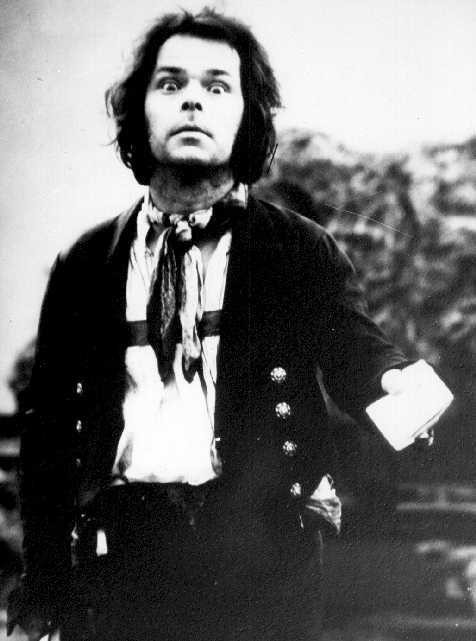On this date in film, Kasper Hauser (Bruno S.) – a feral child who has been locked away for some twenty years – is discovered walking the streets of Nuremberg, in Werner Herzog’s The Enigma of Kaspar Hauser (1974).
The film is based on a true life account from 1828 which, to this day, is an unresolved mystery. As a result of his captivity, Hauser is barely able to walk, talk, read or write. At the beginning of the film, we see Kaspar chained in a cellar, playing with a wooden horse. His captor encourages him to practice his writing and, having taken Kaspar from his prison, teaches him to walk by standing behind him, kicking his heels. The man leaves Kaspar in the centre of town holding a letter in one hand and a bible in the other; for reasons unknown.
The townspeople take Kaspar in and teach him to speak and read. Soon, however, he becomes a strain to the town’s coffers, so the council decides to cash in on Kaspar’s notoriety by having him appear in the local circus freak show. Even when, under the tutelage of kindly Professor Daumer (Walter Ladengast), he is briefly adopted by a foppish English Lord, Kaspar is unable to escape the pointing fingers and gawping expressions of the local gentry. The circus show continues, albeit as part of a different social strata.

Herzog’s extensive canon reveals his affections for the weird and wonderful underdogs who are not accepted by society. From his earliest features, such as Even Dwarfs Started Small (1970), through to Fitzcarraldo (1982), and more recent films like his ‘non-remake’ of Bad Lieutenant (2009), Herzog is fascinated by the eccentricities of those whose vision of the world is warped in some way. Of course, this theme continues into his documentary features – Land of Silence and Darkness (1971), My Best Fiend (1999), Grizzly Man (2005) – and there has always been a ‘cross-pollination’, a fluidity, between his approaches to both.
As such, Bruno S. does not give a performance as such. Rather Herzog observes him ‘becoming’ Kaspar Hauser, embodying the character through bug-eyed stares and his distinctive, deliberate delivery of lines. The fact/fiction divide is further blurred due to Bruno’s own incarceration in numerous mental institutions for two decades. It is a mesmerising routine, full of pathos and humour as he repeatedly confounds and frustrates the religious, educational and medical experts who come to ‘fix’ him. Indeed it is unsurprising, given Herzog’s own philosophy, that by the end of the film we can’t help but think Kaspar would have been better off in his cell and away from the cruelty, cynicism and exploitation of the ‘real world’.

